
What are the best BEL 20 ETFs?
Discover the top-performing BEL 20 ETFs, which offer investors a diversified and cost-effective way to gain exposure to the Belgian stock market. These ETFs track the performance of the BEL 20 index, comprising Belgium's largest and most liquid companies, providing an opportunity for both local and international investors to capitalize on the country's economic growth and market potential.


